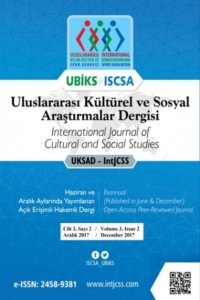Judeo-Spanish and Turkish Proverbs and Idioms with Djoha and Hodja Nasrettin: Questioning Wittiness via Conceptual Metaphors
Öz
This paper analyzes Judeo-Spanish
and Turkish proverbs and idioms where Hodja Nasrettin (he is known as Djoha in
Judeo-Spanish) is depicted as a joyful, gullible, nasty, or an intelligent person.
It suggests that some different and similar conceptualizations are employed in the
proverbs and idioms of both languages in order to describe Hodja Nasrettin from
an anthropological linguistic point of view. These conceptualizations of the
concept of cleverness and credulity are based on the Conceptual Metaphor Theory
of Lakoff and Johnson (1980); however, the two researchers had never mentioned these
conceptualizations in their works. These conceptualizations related to cultural
and social experiences of Judeo-Spanish and Turkish speakers have been presented
in this study for the first time. Besides, in Turkish Hodja is an old character,
whereas in Judeo-Spanish, he is presented sometimes as an old, and sometimes as
a young character. However, he gives advice to people from different age groups.
Anahtar Kelimeler
Cognitive Linguistics Conceptual Metaphors Nasrettin Hodja effects of the Ottoman culture on Turkish Sephardim
Kaynakça
- Avcıkurt, A. (1993). Non-Regional Variation in Present-Day Judeo-Spanish in Istanbul, Unpublished Ph.D. thesis, Hacettepe University, English Linguistics, Ankara, 1993.
- Bardavid, B. (1997). Bizim Hoca - Nasreddin Hoca, Toplumbilim (6), 87 - 96.
- Clewlow, D. F. (1990). Judeo-Spanish: An Example from Rhodes. Unpublished M.A. thesis, University of British Columbia, Hispanic and Italian Studies, British Columbia.
- Duymaz, Recep. (2005). Atalar Sözü, Istanbul, Bilimevi Basın Yayın Ltd. Şti.
- Harris, T. (2005). What Language Did the Jews Speak in Pre-Expulsion Spain? In G. K. Zucker (Ed.), Sephardic identity: Essays on a vanishing Jewish culture (pp. 99-111). Jefferson, North Carolina & London: McFarland & Company, Inc. Publishers.
- Koen – Sarano, Matilda. (1991). Djoha Ke Dize? Kuentos Populares Djudeo-Espanyoles, Jerusalem, Kana.
- Kövecses, Z. (1995). The “Container” Metaphor of Anger in English, Chinese, Japanese, and Hungarian. In Z. Radman (Ed.), From a Metaphorical Point of View: A Multidisciplinary Approach to the Cognitive Content of Metaphor (pp. 117 – 145.). Berlin & New York: Walter de Gruyter.
- Kövecses, Z. (1988). The Language of Love. Lewisburgh: Associated University Press.
- Kövecses, Z. and Szabcó, P. (1996). Idioms: A View from Cognitive Semantics, Applied Linguistics, 17 (3), 326 - 355.
- Lakoff, G. and Johnson, M. (1980). Metaphors We Live By. Chicago, The University of Chicago Press. Püsküllüoğlu, Ali. (1998) Türkçe Deyimler Sözlüğü, Ankara, Arkadaş.
- Radden, G. and Kövecses, Z. (1999). Towards a Theory of Metonymy. In K.-U. Panther & G. Radden (Eds.), Metonymy in language and thought (pp. 17 – 60). Amsterdam: J. Benjamins Pub.
- Sansal, B. (2007). Nasreddin Hodja. Retrieved November 06, 2007, from: http://www.allaboutturkey.com/nasreddin.htm
- Sarhon, K. (n. d.). Judeo-Spanish Language and Culture. Retrieved March 01, 2006, from Sephardic Center: http://www.istanbulsephardiccenter.com/index.php?contentId=41&mid=31
- Ungerer, F. and Schmid, H. J. (1997). An Introduction to Cognitive Linguistics, London & New York, Longman.
- Yu, N. (2003). Metaphor, Body, and Culture: The Chinese Understanding of Gallbladder and Courage. Metaphor and Symbol, 18 (1), 13 - 31.
Öz
Kaynakça
- Avcıkurt, A. (1993). Non-Regional Variation in Present-Day Judeo-Spanish in Istanbul, Unpublished Ph.D. thesis, Hacettepe University, English Linguistics, Ankara, 1993.
- Bardavid, B. (1997). Bizim Hoca - Nasreddin Hoca, Toplumbilim (6), 87 - 96.
- Clewlow, D. F. (1990). Judeo-Spanish: An Example from Rhodes. Unpublished M.A. thesis, University of British Columbia, Hispanic and Italian Studies, British Columbia.
- Duymaz, Recep. (2005). Atalar Sözü, Istanbul, Bilimevi Basın Yayın Ltd. Şti.
- Harris, T. (2005). What Language Did the Jews Speak in Pre-Expulsion Spain? In G. K. Zucker (Ed.), Sephardic identity: Essays on a vanishing Jewish culture (pp. 99-111). Jefferson, North Carolina & London: McFarland & Company, Inc. Publishers.
- Koen – Sarano, Matilda. (1991). Djoha Ke Dize? Kuentos Populares Djudeo-Espanyoles, Jerusalem, Kana.
- Kövecses, Z. (1995). The “Container” Metaphor of Anger in English, Chinese, Japanese, and Hungarian. In Z. Radman (Ed.), From a Metaphorical Point of View: A Multidisciplinary Approach to the Cognitive Content of Metaphor (pp. 117 – 145.). Berlin & New York: Walter de Gruyter.
- Kövecses, Z. (1988). The Language of Love. Lewisburgh: Associated University Press.
- Kövecses, Z. and Szabcó, P. (1996). Idioms: A View from Cognitive Semantics, Applied Linguistics, 17 (3), 326 - 355.
- Lakoff, G. and Johnson, M. (1980). Metaphors We Live By. Chicago, The University of Chicago Press. Püsküllüoğlu, Ali. (1998) Türkçe Deyimler Sözlüğü, Ankara, Arkadaş.
- Radden, G. and Kövecses, Z. (1999). Towards a Theory of Metonymy. In K.-U. Panther & G. Radden (Eds.), Metonymy in language and thought (pp. 17 – 60). Amsterdam: J. Benjamins Pub.
- Sansal, B. (2007). Nasreddin Hodja. Retrieved November 06, 2007, from: http://www.allaboutturkey.com/nasreddin.htm
- Sarhon, K. (n. d.). Judeo-Spanish Language and Culture. Retrieved March 01, 2006, from Sephardic Center: http://www.istanbulsephardiccenter.com/index.php?contentId=41&mid=31
- Ungerer, F. and Schmid, H. J. (1997). An Introduction to Cognitive Linguistics, London & New York, Longman.
- Yu, N. (2003). Metaphor, Body, and Culture: The Chinese Understanding of Gallbladder and Courage. Metaphor and Symbol, 18 (1), 13 - 31.
Ayrıntılar
| Konular | Sanat ve Edebiyat |
|---|---|
| Bölüm | Derleme |
| Yazarlar | |
| Yayımlanma Tarihi | 30 Aralık 2017 |
| Gönderilme Tarihi | 2 Ağustos 2017 |
| Kabul Tarihi | 26 Kasım 2017 |
| Yayımlandığı Sayı | Yıl 2017 Cilt: 3 Sayı: 2 |
Uluslararası Kültürel ve Sosyal Araştırmalar Dergisi


